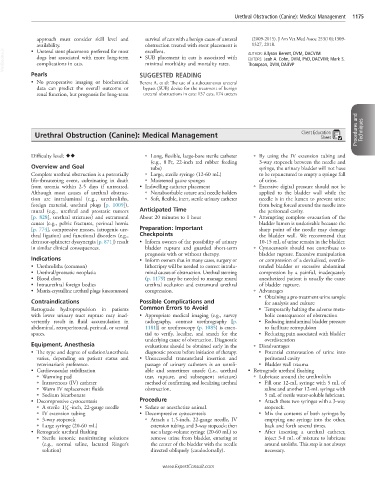Page 2377 - Cote clinical veterinary advisor dogs and cats 4th
P. 2377
Urethral Obstruction (Canine): Medical Management 1175
approach must consider skill level and survival of cats with a benign cause of ureteral (2009-2015). J Am Vet Med Assoc 253(10):1309-
availability. obstruction treated with stent placement is 1327, 2018.
VetBooks.ir dogs but associated with more long-term • SUB placement in cats is associated with AUTHOR: Allyson Berent, DVM, DACVIM
• Ureteral stent placement: preferred for most
excellent.
EDITORS: Leah A. Cohn, DVM, PhD, DACVIM; Mark S.
minimal morbidity and mortality rates.
complications in cats.
Thompson, DVM, DABVP
Pearls SUGGESTED READING
• No preoperative imaging or biochemical Berent A, et al: The use of a subcutaneous ureteral
data can predict the overall outcome or bypass (SUB) device for the treatment of benign
renal function, but prognosis for long-term ureteral obstructions in cats: 137 cats, 174 ureters
Procedures and Techniques
Urethral Obstruction (Canine): Medical Management Client Education
Sheet
Difficulty level: ♦♦ ○ Long, flexible, large-bore sterile catheter ○ By using the IV extension tubing and
(e.g., 8 Fr, 22-inch red rubber feeding 3-way stopcock between the needle and
Overview and Goal tube) syringe, the urinary bladder will not have
Complete urethral obstruction is a potentially ○ Large, sterile syringe (12-60 mL) to be repunctured to empty a syringe full
life-threatening event, culminating in death ○ Moistened gauze sponges of urine.
from uremia within 2-5 days if untreated. • Indwelling catheter placement ○ Excessive digital pressure should not be
Although most causes of urethral obstruc- ○ Nonabsorbable suture and needle holders applied to the bladder wall while the
tion are intraluminal (e.g., urethroliths, ○ Soft, flexible, inert, sterile urinary catheter needle is in the lumen to prevent urine
foreign material, urethral plugs [p. 1009]), from being forced around the needle into
mural (e.g., urethral and prostatic tumors Anticipated Time the peritoneal cavity.
[p. 828], urethral strictures) and extramural About 20 minutes to 1 hour ○ Attempting complete evacuation of the
causes (e.g., pelvic fractures, perineal hernia bladder lumen is undesirable because the
[p. 774], compressive masses, iatrogenic ure- Preparation: Important sharp point of the needle may damage
thral ligation) and functional disorders (e.g., Checkpoints the bladder wall. We recommend that
detrusor-sphincter dyssynergia [p. 871]) result • Inform owners of the possibility of urinary 10-15 mL of urine remain in the bladder.
in similar clinical consequences. bladder rupture and guarded short-term ○ Cystocentesis should not contribute to
prognosis with or without therapy. bladder rupture. Excessive manipulation
Indications • Inform owners that in many cases, surgery or or compression of a devitalized, overdis-
• Urethroliths (common) lithotripsy will be needed to correct intralu- tended bladder or excessive abdominal
• Urethral/prostatic neoplasia minal causes of obstruction. Urethral stenting compression by a painful, inadequately
• Blood clots (p. 1179) may be needed to manage mural anesthetized patient is usually the cause
• Intraurethral foreign bodies urethral occlusion and extramural urethral of bladder rupture.
• Matrix-crystalline urethral plugs (uncommon) compression. ○ Advantages
■ Obtaining a pre-treatment urine sample
Contraindications Possible Complications and for analysis and culture
Retrograde hydropropulsion in patients Common Errors to Avoid ■ Temporarily halting the adverse meta-
with lower urinary tract rupture may inad- • Appropriate medical imaging (e.g., survey bolic consequences of obstruction
vertently result in fluid accumulation in radiography, contrast urethrography [p. ■ Reducing intraluminal bladder pressure
abdominal, retroperitoneal, perineal, or scrotal 1181]) or urethroscopy (p. 1085) is essen- to facilitate retropulsion
spaces. tial to verify, localize, and search for the ■ Reducing pain associated with bladder
underlying cause of obstruction. Diagnostic overdistention
Equipment, Anesthesia evaluations should be obtained early in the ○ Disadvantages
• The type and degree of sedation/anesthesia diagnostic process before initiation of therapy. ■ Potential extravasation of urine into
varies, depending on patient status and • Unsuccessful transurethral insertion and peritoneal cavity
veterinarian’s preference. passage of urinary catheters is an unreli- ■ Bladder wall trauma
• Cardiovascular stabilization able and sometimes unsafe (i.e., urethral • Retrograde urethral flushing
○ Warming pad tear, rupture, and subsequent stricture) ○ Lubricate around the urethroliths
○ Intravenous (IV) catheter method of confirming and localizing urethral ■ Fill one 12-mL syringe with 5 mL of
○ Warm IV replacement fluids obstruction. saline and another 12-mL syringe with
○ Sodium bicarbonate 5 mL of sterile water-soluble lubricant.
• Decompressive cystocentesis Procedure ■ Attach these two syringes with a 3-way
○ A sterile 1 2 -inch, 22-gauge needle • Sedate or anesthetize animal. stopcock.
1
○ IV extension tubing • Decompressive cystocentesis ■ Mix the contents of both syringes by
○ 3-way stopcock ○ Attach a 1.5-inch, 22-gauge needle, IV emptying one syringe into the other,
○ Large syringe (20-60 mL) extension tubing, and 3-way stopcock; then back and forth several times.
• Retrograde urethral flushing use a large-volume syringe (20-60 mL) to ■ After inserting a urethral catheter,
○ Sterile isotonic nonirritating solutions remove urine from bladder, entering at inject 3-8 mL of mixture to lubricate
(e.g., normal saline, lactated Ringer’s the center of the bladder with the needle around uroliths. This step is not always
solution) directed obliquely (caudodorsally). necessary.
www.ExpertConsult.com

